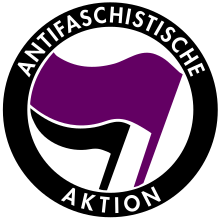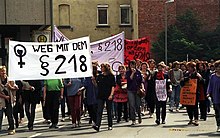Fantifa
Central Europe Germany Italy Spain (Spanish Civil War) Albania Austria Baltic states Belgium Bulgaria Burma China Czechia Denmark France Germany Greece Italy Japan Jewish Luxembourg Netherlands Norway Poland Romania Slovakia Spain Soviet Union Yugoslavia Germany Italy Netherlands Portugal Spain Sweden Switzerland United Kingdom United States Fantifa (sometimes rendered as f_antifa[1] or f*antifa;[2] a contraction of German Feministische Antifa, lit.
[3]: 5 The main fantifa movement holds an anarcho-communist philosophy and is specifically an anti-fascist variant of anarcha-feminism, as is sometimes represented in the use of a purple and black flag with a symbol derivative of that of the men's antifa group Antifaschistische Aktion.
In 1980, Rote Zora issued a statement urging feminists to take action against every form of oppression, including that imposed by the state.
The term "fantifa" was coined in 1988,[5] with small meetings of no more than fifteen people occurring in 1989, which covered topics including violence against women.
[3] Following the fall of the Berlin Wall, the first nationwide German fantifa meeting was held on the weekend of January 20-21, 1990,[5] covering the topics of lesbophobia, eugenics, anti-abortion movements, and § 218.
[6] Fantifa initially met with conflict from antifa men who viewed women's rights groups as fascist, perceiving feminism's antagonism toward patriarchy as misandry equivalent to antisemitic hatred.
[11] In 2016, fantifa participated in a Goethe University Frankfurt student effort to aggregate reports of abuse committed by pickup artists.
[14] In 2020, fantifa activists performed various destructive but nonviolent acts of vandalism such as throwing a stink bomb into a neo-Nazi tattoo parlor.
[17] Members of Bonn-based fantifa group Fantifa Bonn identified anti-abortion activist Dr. Ferdinand Oeter as a former Nazi seemingly attempting to bolster the reproduction of white German citizens as an exercise in eugenics and to seed the culture with values that would support a return to fascism, having previously made a 1937 statement indicating the importance of keeping women in traditional gender roles as mothers and homemakers to rescue a perceived dying essential whiteness and bolster cultural Nazism.
[3]: 32 Oeter was a member of the Deutsche Liga für das Kind (German League for Children), an antifeminist group part of a movement fighting for a state subsidy for women to become stay-at-home mothers.
[20] Though rooted in radical feminist theory, fantifa's focus on the opposition of fascism generally keeps it from embracing conservative variants of feminism.
Particularly, the persecution of homosexuals in Nazi Germany and neo-Nazi targeting of transgender and intersex people influences fantifa to reject gender-critical feminism.
[22] Though the vast majority of fantifa members are white able-bodied cis women of middle-class academic backgrounds, they try to encourage diversity in their movement.
To prepare for cases where violence is unavoidable, fantifa promotes women learning self-defense skills such as Wen-Do but emphasizes not delivering the first blow.


